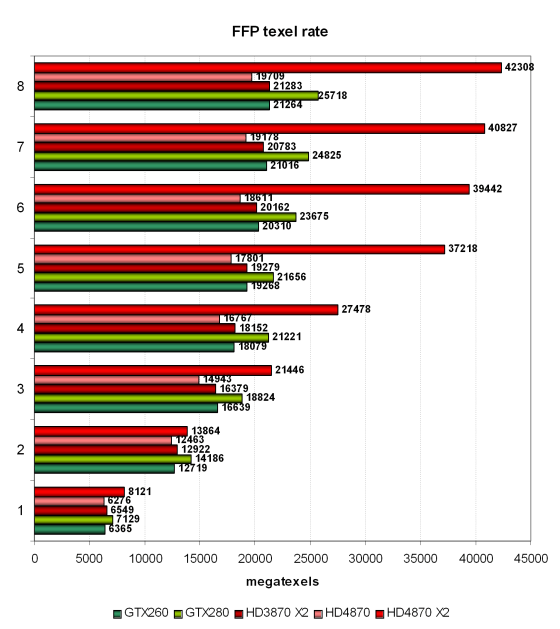ATI RADEON HD 4870 X2 2x1024MB
|
Performance
Testbed configuration
- Intel Core2 Extreme QX9650 (3000 MHz) CPU
- Zotac 790i Ultra motherboard on NVIDIA nForce 790i Ultra
- 2GB DDR3 SDRAM Corsair 2000MHz (CAS (tCL)=5, RAS to CAS delay (tRCD)=5, Row Precharge (tRP)=5, tRAS=15)
- WD Caviar SE WD1600JD 160GB SATA hard drive
- Tagan TG900-BZ 900W PSU
- Windows Vista 32bit SP1, DirectX 10.1
- Dell 3007WFP 30-inch monitor
- ATI CATALYST 8.7; NVIDIA Forceware 177.79
- VSync disabled
Synthetic tests
Benchmarks
RightMark3D 2.0 requires MS Visual Studio 2005 runtime as well as the latest DirectX runtime update.
Graphics cards
- RADEON HD 4870 X2 with standard parameters (HD4870X2)
- RADEON HD 4870 with standard parameters (HD4870)
- RADEON HD 3870 X2 with standard parameters (HD3870X2)
- NVIDIA GeForce GTX 280 with standard parameters (GTX280)
- NVIDIA GeForce GTX 260 with standard parameters (GTX260)
- NVIDIA GeForce 9800 GX2 with standard parameters (GF9800GX2)
We selected them to compare with RADEON HD 4870 X2 for the following reasons: RADEON HD 3870 X2 is a similar dual-GPU solution from AMD based on the previous architecture, so it will help evaluate the effect of improvements and performance differences. The HD 4870 will be used to see performance gains from using the second GPU. Now what concerns NVIDIA graphics cards: GeForce 9800 GX2 is the only dual-GPU card from NVIDIA based on the previous G9x architecture; both GeForce GTX 200 cards are actually competitors of RADEON HD 4870 X2, although the latter is a tad more expensive than the top GPU from NVIDIA.
DX9: Pixel Filling tests
This test determines peak texel rate in FFP mode for different numbers of textures applied to a pixel:
There is nothing interesting here, everything complies with our previous research. As usual, graphics cards do not reach theoretical values, HD 3870 X2 (based on two RV670 GPUs) gets closer to them than the others. What concerns new graphics cards from NVIDIA and AMD, they fail to reach theoretical maximum in this test. Each RV770 in our test looks up fewer than 30 texels per cycle from 32-bit textures with bilinear filtering, short of 40 to reach the theoretical value. NVIDIA cards demonstrate even lower efficiency.
Interestingly, there is more than a two-fold difference between a single HD 4870 and HD 4870 X2, which is apparently beyond a measurement error. This test works well with dual-GPU configurations, and it's hardly affected by hardware changes in the R700.
What concerns the comparison of HD 4870 X2 and GTX 280, the dual-GPU card from AMD significantly outperforms its competitor in this test owing to its dual-GPU nature. Besides, CrossFire starts to demonstrate a two-fold performance gain (or similar) only with more than five textures per pixel. Each additional texture improves relative results of the dual-GPU solution. We can see that memory bandwidth limits performance in case of 1-2 textures. Let's have a look at the fill rate results:

The second synthetic test measures the fill rate. It shows the same situation adjusted for the number of pixels written into the frame buffer. In case of 0, 1, and 2 textures, RADEON HD 4870 X2 does not demonstrate a very high result versus HD 4870, which can be explained by the effect of memory bandwidth and multi-GPU rendering method. As in the previous diagram, the new card shoots forward in situations with lots of textures per pixel, being twice as fast as the card based on a single RV770 and its competitors.
Write a comment below. No registration needed!
|
|
 |
|
|
|


